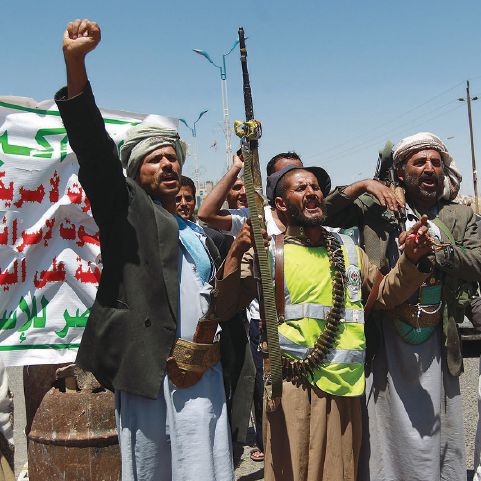Yemen, Mansour al-Nogaidan and Al-Islah
Jamal Khashoggi/Al Arabiya/August 27/15
In an interesting article entitled “Yemen post-liberation: The dangers of division and the return of the Muslim Brotherhood,” Mansour al-Nogaidan drew attention to the future of Yemen from a Saudi-Emirati point of view very close to his own.
Whether there are one or two Yemens, the important thing is that they do not go to war with each other or become hostile to the Gulf states. It would be better not to deal with the issue of southern independence until the full liberation of Yemen. Then Yemenis can decide for themselves between unity, separation or federalism. They should do that without armed conflict as there has been enough war, hunger and misery. Whether there are one or two Yemens, the important thing is that they do not go to war with each other or become hostile to the Gulf states Nogaidan’s article highlights above all the danger of the Brotherhood’s return. According to him, it has returned to play a bigger and more dangerous political role than expected. The Brotherhood is taking part in Yemen’s governance. According to Nogaidan, who is a meticulous researcher, since the end of the civil war in 1970 and the 41 years of the Yemeni republic, the Brotherhood has sided with revolution, including the one in 2011.
Third alternative
Yemen’s Brotherhood was involved in the “third alternative” project in the civil war that was backed by the late Saudi King Faisal at the start of his struggle with then-Egyptian President Gamal Abdel Nasser. The project put forward the idea of an Islamic state instead of royal and republican systems. This movement was formed and led by the late Ibrahim al-Wazir, who was highly educated and part of a prominent Hashemite family. The Brotherhood participated directly in the 1948 reformist revolution from its headquarters in Cairo. This cross-border participation created the first rift between the Brotherhood and the Saudi kingdom, which started to grow suspicious of the movement and its aspirations. An insightful politician takes historical junctures into account and uses them for the benefit of his cause, as did King Faisal. The “third alternative” attracted a number of republican tribal elders to the kingdom’s ranks, even if it happened at the expense of its allies, the royal house and the Hamidaddin clan.
Moreover, one of the most prominent intellectuals Mohammed al-Zubairi was assassinated in northern Yemen while on his way to meet King Faisal in Saudi Arabia, after he broke away from the republicans and formed Hezbollah, which called for an Islamic government rather than a monarchy or republic.As such, the idea of a “third alternative” seeking wise governance in Yemen is old, was multi-faceted, and does not concern the Brotherhood alone. What happened in Yemen after the military took charge and almost forced out King Faisal’s favorite to rule Yemen, Judge Abdul Rahman al-Iryani, was illusion.
Solutions
The current multilateral struggle between the Houthis, former President Ali Abdullah Saleh, the Joint Meeting Parties (JMP), intellectuals, the southern Herak movement and the Brotherhood serves the mother cause: searching for an appropriate formula of wise governance in an unhappy Yemen. Is the Brotherhood’s “return” a source of danger in Yemen? Of course not.
The danger resides in the return of tyranny and the authority of a singular force over a country with different sects, orientations and tribes. Brotherhood monopolization of power in Yemen is as dangerous as the single-handed authority of the Houthis allied to Iran, which sparked the current war. The list goes on with Saleh, who wrongly monopolized power. The Brotherhood’s Al-Islah party will come back stronger in Yemen after the fall of its Houthi rivals and its former ally Saleh. It is the third force left in the north after the fall of the two other forces thanks to the Saudi-led coalition. It would be unwise to repress Al-Islah and consider it a terrorist group. This would make it turn to Al-Qaeda, though the differences between them are huge. Nogaidan proposes stopping “the support of Al-Islah and the strengthening of its influence,” and allowing it “to be weighted normally according to the rules of the new civil life, which prohibits the exploitation of religion and sectarianism, and embraces everyone.” This is the wisest thing to do.
From Yemen to Syria, counter-terrorism alone not the answer
Manuel Almeida/Al Arabiya/August 27/15/
That al-Qaeda, and especially now ISIS, represent a threat to regional and global security is an elementary fact around which the governments of the Arab world, Iran, U.S., Russia, UK or France are in agreement. Yet beyond this basic understanding, they hold very different views on how to deal with the problem of militant jihadism and the various Middle Eastern crises that allow the jihadist propaganda to thrive. This continues to hinder the efforts to tackle the jihadist menace. Take Yemen. The presence of al-Qaeda in the Arabian Peninsula (AQAP) has been generally overshadowed by the ongoing conflict, which opposes pro-government and anti-Houthi forces supported by the Saudi-led coalition to the alliance between the Houthi rebels and military units still loyal to former President Ali Abdullah Saleh. As it becomes clearer that ISIS cannot be defeated without a political solution in Syria and a renegotiated social contract, a basic understanding among the various regional and global powers about the need to negotiate Assad’s way out might not be that far away
However, whenever militants of AQAP or Ansar al-Sharia (a name that emerged as a local rebranding attempt by AQAP) take advantage of the chaos and lawlessness to make a threatening move, widespread demands magnified by regional and especially international press call for a change of priorities toward the fight against militant jihadism. This is what happened a few days ago when AQAP militants attempted to take control of the presidential palace located in Aden’s Tawahi neighbourhood and a military base in the city. A similar case took place in April in the coastal city of al-Mukalla, the capital of Hadhramaut province, when AQAP fighters seized government buildings, robbed the central bank and allegedly backed the formation of a local civilian council that AQAP backs financially.
Ignoring the threat
On both occasions, the Saudi-led coalition and Yemen’s government in exile were blamed for ignoring the threat posed by AQAP and, in the case of more conspiratorial or propagandistic regional media outlets, of actively supporting AQAP in the fight against the Zaydi Houthi rebels. The propaganda of the Houthi rebels themselves equates every mild Sunni Islamist within Yemen’s al-Islah party, which the Houthis turned into a primary target when they took over the capital Sanaa in September last year with AQAP.
What is widely missed in the views that call for the prioritization of counter-terrorism strategies is that the AQAP-first approach that drove U.S. policy toward Yemen during much of Ali Abdullah Saleh’s ruinous era has had limited effects in preventing the spread of AQAP’s tentacles in Yemen. In fact, this U.S. approach to Yemen seems not to have changed much even after Saleh agreed to step aside in 2011 in the context of the Gulf Initiative. The former president of Yemen often honoured a pact of non-aggression with AQAP’s leadership to capitalize on the financial and logistical support for counter-terrorism it received from the U.S., which was then channelled for other purposes. In the meanwhile, the U.S. overreliance on drone strikes to eliminate AQAP’s leaders and militants generated and continues to generate great resentment among local populations.
A comprehensive approach
Only a far more comprehensive approach would be able to eradicate or at least much diminish the presence of AQAP. This can only be achieved by a government with the willingness and capacity to actually rule Yemen, reform the military and security sectors, and manage a much strained economy with regional and international backing. The same stands for Syria. As the Syrian conflict dragged on and radical groups such as Jabaat al-Nusra and then ISIS begun to make their presence felt, the focus in Western capitals started to shift away from the brutalities committed by the pro-Assad camp and support for the moderate opposition to the pressing need to fight the ISIS. For too long, Western governments as well as Russia seem to have been influenced to a certain extent by the narrative, used by the Assad cohort and its main sponsor Iran, that the regime in Damascus was the last bulwark and only hope in Syria against ISIS.
Assad himself greatly contributed to the radicalization of the armed opposition, not only via extremely brutality that included and continues to include the use of chemical weapons against civilians, but by releasing hundreds of militant jihadists from the regime’s jails and avoiding to strike jihadist groups for a long period in the conflict. Nevertheless, the terrorism card that Assad desperately used to play with Western and Russian fears of militant jihadism may well be shifting against him. As it becomes clearer that ISIS cannot be defeated without a political solution in Syria and a renegotiated social contract, a basic understanding among the various regional and global powers about the need to negotiate Assad’s way out might not be that far away.



















